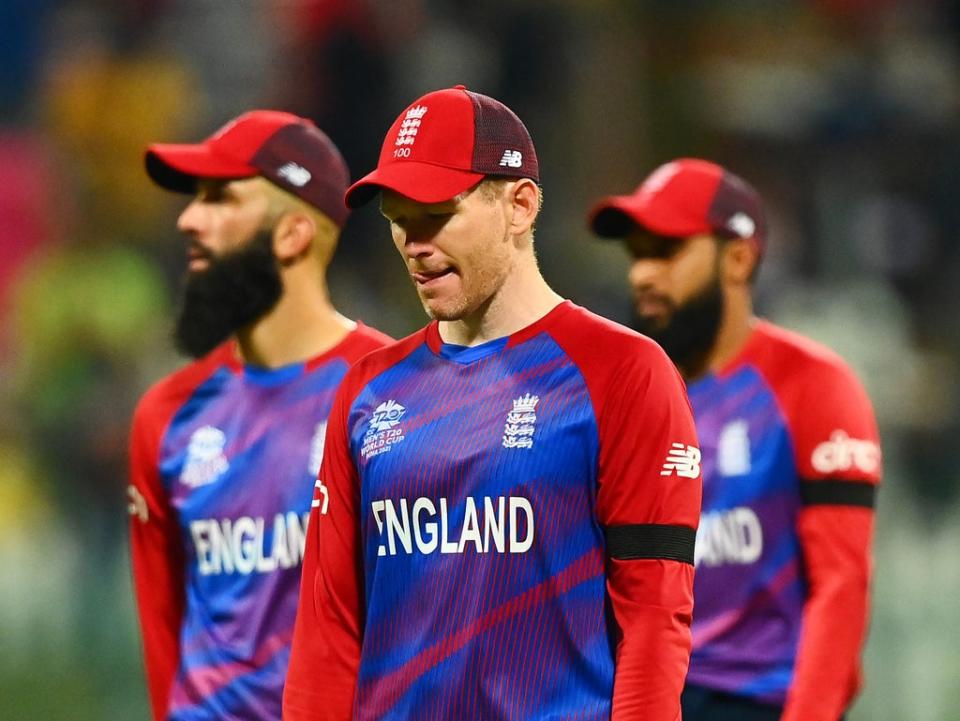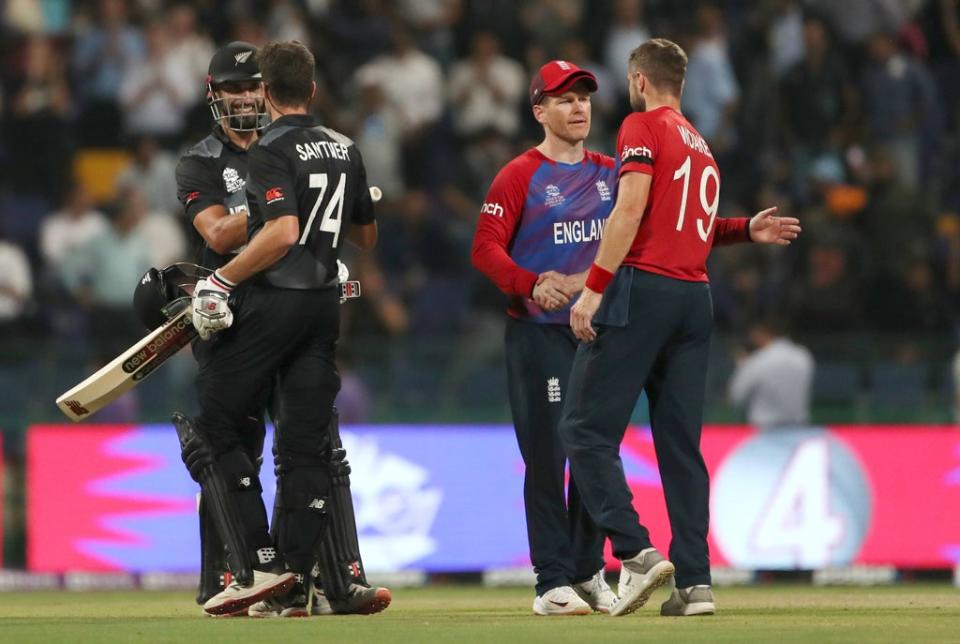England fall again from a T20 World Cup but from a greater height

Is it worse to lose in a semi-final or a final?
Well a final, obviously. To have got so far and have nothing to show for it, then have to watch your opponents lifting the prize you had sacrificed so much to obtain – very few things come close to that kind of pain. At least by losing a stage earlier you don’t get to witness that moment and can perhaps take solace that you lost to the eventual winners. As they say in the Olympics, the best place to stand on a podium is gold, and the second-best is bronze.
Undoubtedly the manner in which England lost the 2016 World T20 final was more devastating than Wednesday night’s dramatic defeat to New Zealand in the semi-final in Abu Dhabi. You’d rather defend 19 off the last over than 57 off the last four. But you would expect to emerge victorious both times.
Unless, of course, you are on the end of something quite remarkable. Twice. Just as it was with Marlon Samuels reinforced by Carlos Brathwaite five years ago, Daryl Mitchell and Jimmy Neesham provided 2021’s crushing blow.
What makes this one harder to swallow was the expectation. Captain Eoin Morgan and his players, along with head coach Chris Silverwood and the data analysts, will look at how they can ensure such disappointment does not happen again. But for now, egos and spirits will be severely bruised. Before the “how” will come the “why” did that happen to us – again?
Viewing Twenty20 cricket as “volatile” is one way to alleviate the pain. But enough of it has been played to know when those volatile moments occur. And for England, it’s usually when they have the ball in hand defending a total. Which is why they have tried to avoid it as much as possible.
Since the start of 2019, they have won the toss 17 times and not once chosen to bat first. Of course knowing your target is useful when it comes to mapping out your order and match-ups, and also having seen how the pitch has played in the previous 20 overs.
It is also an unparalleled strength for a batting unit that has something for every conceivable circumstance, hence why they’ve achieved 14 of the 20 targets they have been set over the last 23 months. And so in the lead-up to this tournament – originally due to take place over in Australia last year – England focused on honing their stronger suit. Wednesday was only the fifth time England had batted first – no matter if they had won or lost the toss – in their last 17 T20s.
It might be heresy to say that the most progressive T20 team fell short by not being experimental enough, but in the immediate aftermath of such a defeat, it is one of the few controllables to clutch. And it was hard not to wonder if avoiding being under pressure for all this time has given England’s bowling group a weaker chin. The only way to know if you can take a punch is, unfortunately, to get punched.
The old adage of your opponent being allowed a full day out also comes into play here. Mitchell’s Jekyll-and-Hyde innings, of quiet man (his first 40 balls produced 46) and then beast (26 off seven to finish unbeaten on 72) was like watching the 18-year evolution of the format in a couple of hours. Jimmy Neesham’s 27 off 11 was the extrapolation of the six he hit into the chin of Old Father Time at Lord’s back in 2019’s Super Over. “We've played against Jimmy a lot,” said Morgan. “He's not struck the ball like that against us ever.”

Yet there was Moeen Ali, so effective with the ball, making do as a batter only some seven years too late. Were England trying to be too smart with unfavourable match-ups? And what of those batters? One spare with Sam Billings, in for the injured Jason Roy, who didn’t make it out to the middle.
An extra bowler instead was floated before the match, though not so much by the England camp. Perhaps left-arm seamer David Willey, who is an accomplished domestic T20 hitter. The extra option might have allowed Chris Woakes to bowl out earlier when the ball was newer, which would have pushed England further along given his first three had taken two for 16. Likewise for Chris Jordan, whose first two over went for 10 before his third in the 17th over went for a match-turning 23.
But they decided to re-equip their strengths because they are so comprehensive they cover for the bowling. They were no doubt encouraged by the progress of Liam Livingstone. The 28-year-old is perhaps the breakout star of this tournament, wedding his six-striking ability with immeasurably improved leg- and off-spin bowling. He came into this tournament without ever bowling a full set of four for England and has now done so twice. His two for 22, featuring 12 dot balls and just two boundaries against his name, was a Neesham away from being game-changing.
But on these pitches in the United Arab Emirates, big scores are not the norm and so, sooner rather than later – or as it was in the final Super 12 match defeat to South Africa – the bowling would have to do more than their usual share. And while there will be some who will say England believed their hype too much, it’s perhaps much simpler and less arrogant than that. Maybe they were just too comfortable with how well they have been doing.

It’s important to note England were without Jofra Archer, Ben Stokes and Sam Curran coming into this tournament, then losing a world-best death bowler in Tymal Mills and opener in Roy before the knock-out stages. If ever there was a painful English defeat in a World Cup to suppress that knee-jerk reflex, this is it.
That does not mean this isn’t one to rue. Were they too readily wed to the analytics? Too intent on honing their chasing when they could have focused on the other side while still maintaining a lead over the rest? Could those bilateral series since 2016 have been used more proficiently, especially considering the series with India earlier this year was the first time they had assembled their full strength squad since the previous tournament?
We might never know the answers to those questions, and moreover, they may never need to be addressed. The next T20 World Cup is next winter; on more batting-friendly Australian decks, it represents an ideal do-over. England can still become the first team to hold 50-over and 20-over World Cup titles concurrently, and Morgan can still be a reigning captain of both if he chooses to stay on. And though there is a crop of young hungry batters coming through, the bowling is likely to remain the same, even boosted by the returns of Archer and Mills.
The issue will be how these players re-emerge from this low. In 2016, their pain was because they fell at the very last moment when no one expected them to make it that way. Five years on, the angst feels greater for the No 1 ranked side and favourites. Not just because they fell earlier, but from a greater height.
Read More
Yorkshire racism scandal must ‘never happen again’ in cricket, Joe Root insists
The key questions after England’s T20 World Cup semi-final defeat
Neesham fires as Buttler falls short – key moments as New Zealand beat England
England knocked out of T20 World Cup as New Zealand exact revenge to reach final
England vs New Zealand: Talking points ahead of T20 World Cup semi-final
England and New Zealand compared ahead of T20 World Cup semi-final

 Yahoo Sport
Yahoo Sport 





































